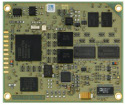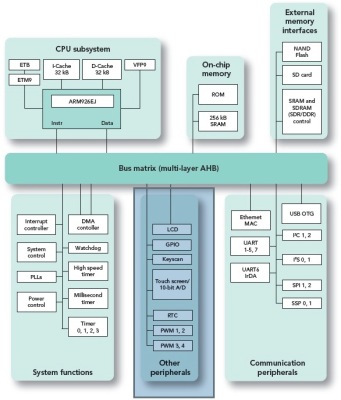Linux-friendly CPU module boasts 90nm ARM9 SoC
Apr 24, 2008 — by LinuxDevices Staff — from the LinuxDevices Archive — 11 views PhyTec is readying a small CPU module powered by an ARM9-based SoC (system-on-chip) built on 90 nanometer process technology. The PhyCore-LPC3250 weds seven serial ports with “state-of-the-art” power management, and targets consumer, medical, industrial, and automotive applications, PhyTec says.
PhyTec is readying a small CPU module powered by an ARM9-based SoC (system-on-chip) built on 90 nanometer process technology. The PhyCore-LPC3250 weds seven serial ports with “state-of-the-art” power management, and targets consumer, medical, industrial, and automotive applications, PhyTec says.
(Click here for slightly larger image of the PhyCore-LPC3250)
NXP's LPC3250
As its name signifies, the PhyCore-LPC3250 module is based on NXP's newly introduced LPC3250 SoC (system-on-chip). As part of NXP's LPC3000 family, it is among the first 90 nanometer ARM9 SoCs, NXP says. It uses an ARM926EJ-S core clocked at 208MHz, and comes in a 296-pin TFBGA (thin fine pitch ball grid array) package.

A block diagram of NXP's LPC3250
(click to enlarge)
Touted advantages of the NXP microcontroller include a hardware VFP that is said to “increase the speed of typical calculations by a factor of four to five in scalar mode, and much more in optimized vector mode.” The LPC3250 also has an MMU (memory-management unit) for complex OS support, plus a USB On-The-Go host/device interface.
The LPC3250 can boot up from NAND flash, SPI memory, USB, UART, or static memory. It also features a stop mode that saves power, while allowing many peripheral functions to restart CPU activity, says NXP.
Other features and specifications listed by NXP for the LPC3250 include:
- 32KB instruction cache and 32KB data cache.
- Up to 256KB of internal SRAM
- External memory controller for DDR and SDR SDRAM, as well as static devices
- NAND flash controllers for SLC and MLC devices
- A master interrupt controller and two slave interrupt controllers (SIC), supporting 74 interrupt sources
- An eight channel DMA controller (GPDMA)
- 10/100 Ethernet MAC with dedicated DMA Controller
- Four standard UARTs with fractional baud rate generation and 64byte FIFOs, one supporting IrDA
- Three additional high-speed UARTs intended for on-board communications, supporting baud rates up to 921,600bps and providing 64byte FIFOs
- 2 x SPI controllers
- 2 x SSP controllers
- 2 x I2C-bus interfaces
- 2 x I2S interfaces
- LCD controller supporting both STN and TFT panels, with dedicated DMA controller and resolution up to 1024×768
- SD interface
- GPIO with 12 GP input pins, 24 GP output pins, and 51 GP I/O poins
- 10-bit, 400KHz A/D converter, operable as a touch screen controller
- Real time clock (RTC)
- Watchdog timer
- Keyboard scanner function with automatic scanning of up to an 8×8 key matrix
- Standard ARM test/debug interface
- Emulation trace buffer allowing trace via JTAG.
- On-chip PLL allows operation up to maximum CPU rate without a high frequency crystal
Phytec's PhyCore-LPC3250
The PhyCore-LPC3250 is a processor module measuring 2.75 x 2.3 inches (70 x 58mm). It supports the functionality, listed above, of the onboard LPC3250 SoC, and also packs from 16MB to 128MB of SDRAM, and from 32MB to 128MB of NAND flash.
The module passes all signals to a separately available carrier board via two 160-pin Molex connectors. The carrier board, which is apparently still under development, enables startup, programming, and debugging of the module. It also includes standard I/O connectors and other interface circuitry not provided on the module itself.
Features and specifications cited by PhyTec for the PhyCore-LPC3250 and carrier module include:
- Processor — NXP LPC3250 clocked at 208MHz
- Memory:
- SDRAM — 16MB, 32MB, 64MB, or 128MB
- NOR flash — 1MB, 2MB, 4MB, or 8MB
- NAND flash — 16MB, 32MB, 64MB, 128MB
- SDRAM — 16MB, 32MB, 64MB, or 128MB
- Display — PhyTec universal LCD display interface
- Keyboard — 9-button, plus power and system reset buttons
- Networking — 10/100 Ethernet with RJ45 connector
- Other I/O:
- USB host, client, and OTG connectors
- 2 x DB9 serial ports, plus additional serial ports via headers
- Microphone and line in/out audio jacks
- Power connector
- USB host, client, and OTG connectors
- Expansion:
- SD slot
- Additional two 160-pin Molex connectors available
- SD slot
- Operating temperature — TBD (-40 to 85 deg. C is planned)
- Dimensions — 2.75 x 2.3 inches for module, carrier board size TBD
Further information
The PhyCore-LPC3250 module and carrier board will be available in July. The module itself costs $400, the module and carrier board together cost $579. An optional 3.5-inch touchscreen display add-on is $145.
Phytec plans to offer a Linux 2.6 BSP (board support package) for the PhyCore-LPC3250. However, the BSP is still in development, as is a Windows CE BSP.
This article was originally published on LinuxDevices.com and has been donated to the open source community by QuinStreet Inc. Please visit LinuxToday.com for up-to-date news and articles about Linux and open source.